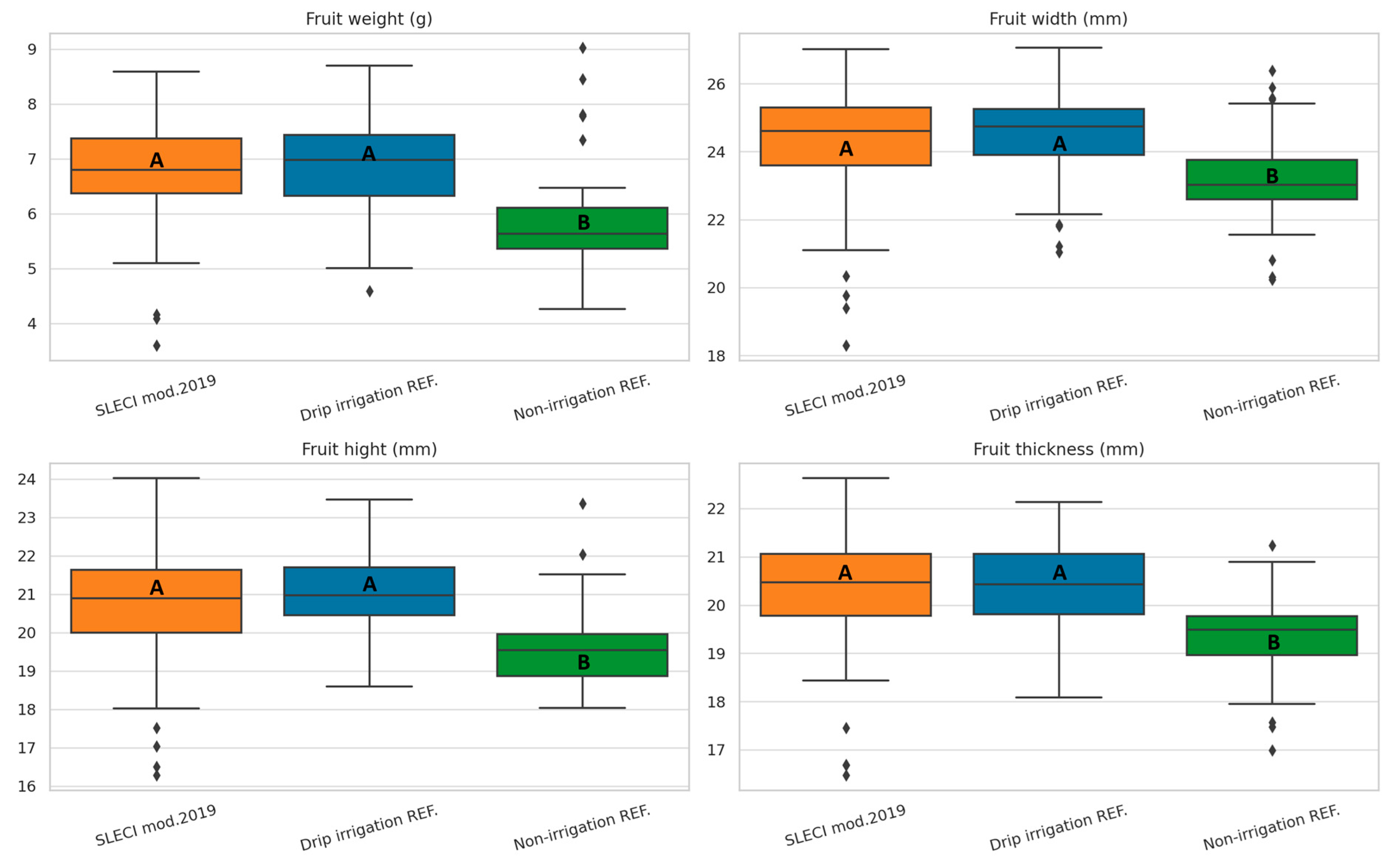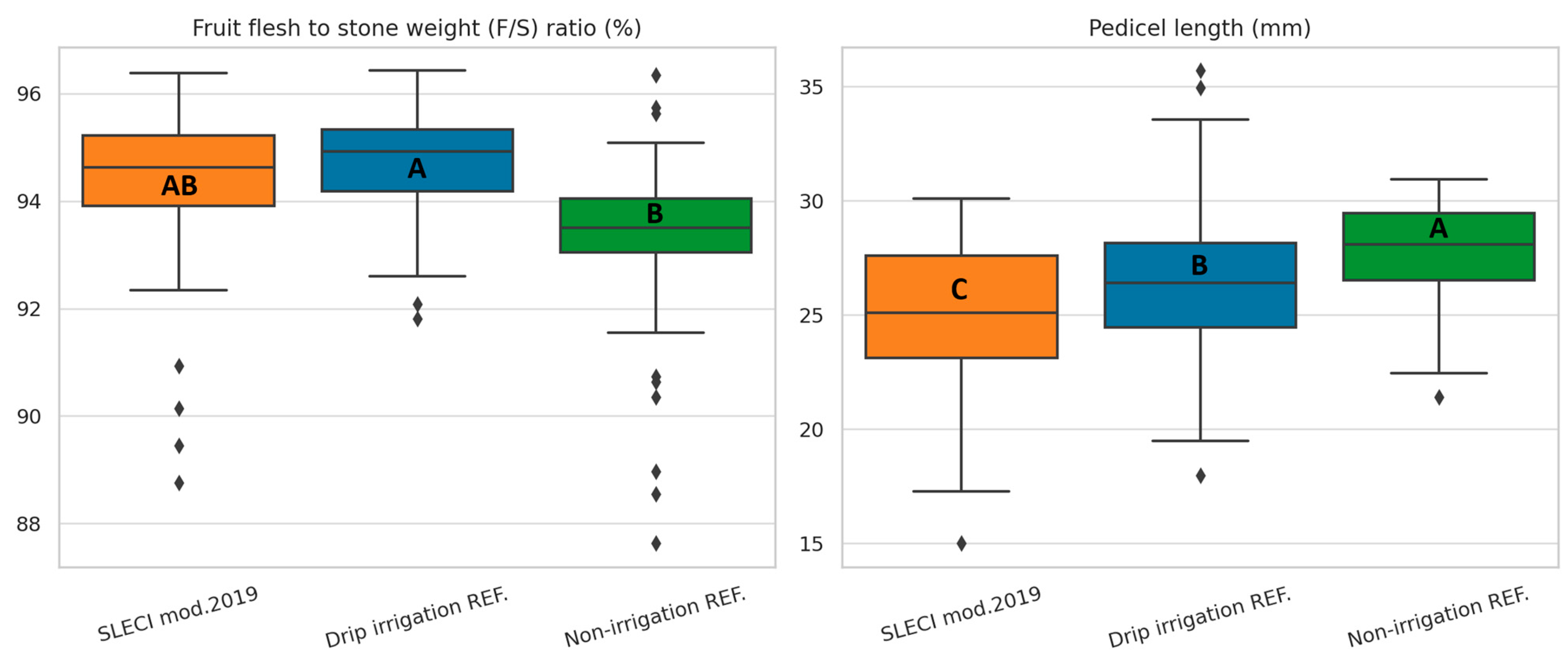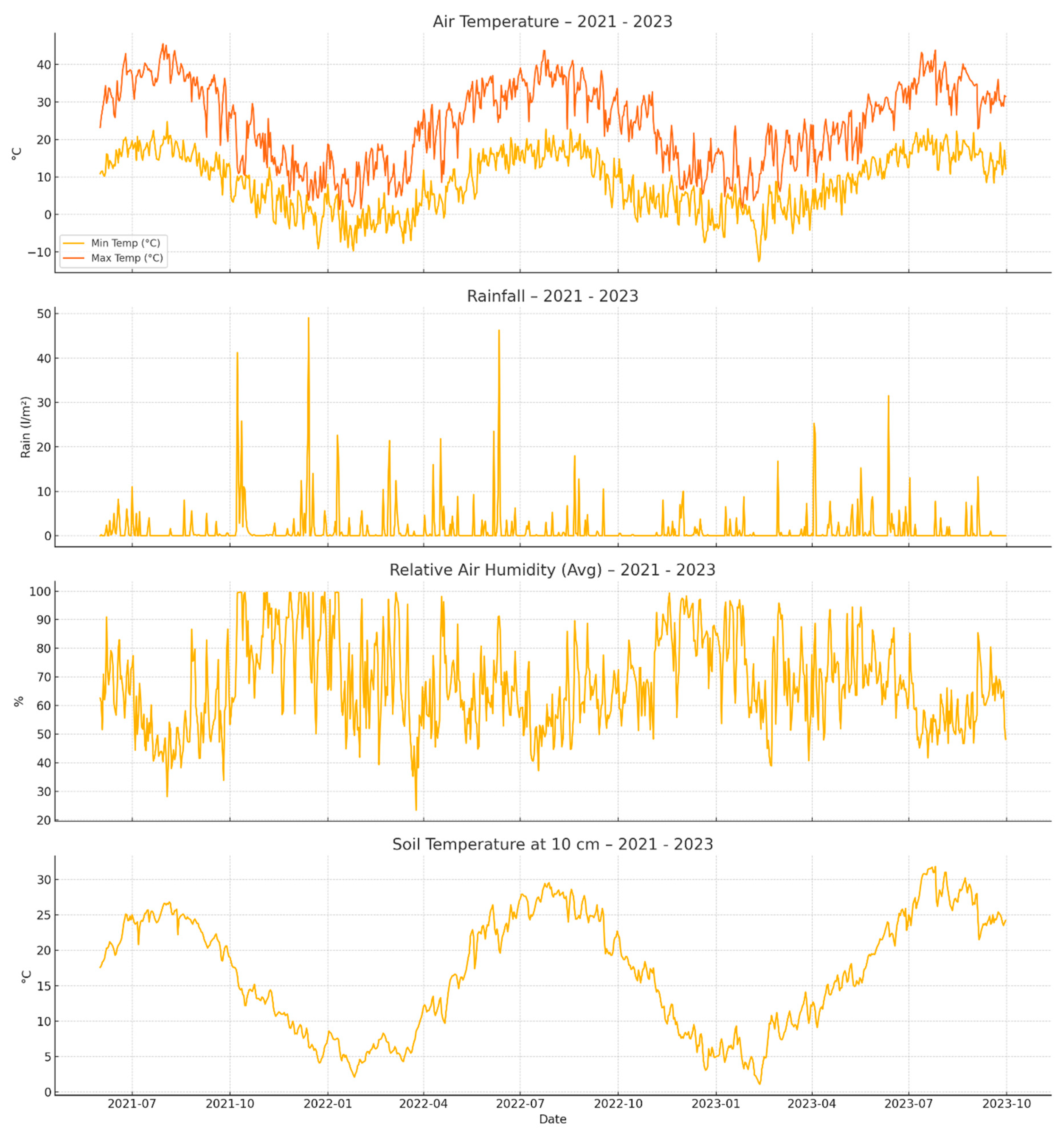Sweet Cherry (Prunus avium L.) Response to Self-Regulating Low Energy Clay-Based Irrigation (S.L.E.C.I.) System
Abstract
1. Introduction
2. Results
2.1. Soil Moisture and Water Consumption
2.2. Irrigation Water Use in Sweet Cherry by Treatments and Years
2.3. Sweet Cherry Yield by Irrigation Treatments and Year
2.4. Irrigation Water Productivity in Sweet Cherry Under SLECI and Drip Irrigation Techniques
2.5. Fruits Quality Traits and Yield
3. Discussion
3.1. S.L.E.C.I. Origin and Principles
3.2. S.L.E.C.I. Development and Testing
3.3. S.L.E.C.I. Alternatives and Competition
3.4. S.L.E.C.I. Future Development and Possible Applications
4. Materials and Methods
4.1. Research Design
4.2. Climate and Soil Conditions at the Experimental Site in Plovdiv, Bulgaria
4.3. Soil Moisture and Water Consumption
4.4. Irrigation Water Productivity Analysis
4.5. Fruits Quality Traits and Yield
4.6. Data Analysis and Processing
5. Conclusions
Author Contributions
Funding
Data Availability Statement
Acknowledgments
Conflicts of Interest
Abbreviations
| SLECI | Self-Regulating, Low Energy, Clay-Based Irrigation |
| SICE | Subsurface Irrigation with Ceramic Emitters |
| CP-SDIL | Ceramic-Patch-Type Subsurface Drip Irrigation Line |
| SDI | Sub-surface drip irrigation |
| IWP | Irrigation water productivity |
| DIVAGRI | 101000348–DIVAGRI “Revenue diversification pathways in Africa through bio-based and circular agricultural innovations” |
References
- Falkenmark, M. Growing Water Scarcity in Agriculture: Future Challenge to Global Water Security. Philos. Trans. R. Soc. A Math. Phys. Eng. Sci. 2013, 371, 20120410. [Google Scholar] [CrossRef] [PubMed]
- Taft, H.L. Water Scarcity: Global Challenges for Agriculture. Food Energy Water Chem. Connect. 2015, 395–429. [Google Scholar] [CrossRef]
- Mancosu, N.; Snyder, R.L.; Kyriakakis, G.; Spano, D. Water Scarcity and Future Challenges for Food Production. Water 2015, 7, 975–992. [Google Scholar] [CrossRef]
- Dinar, A.; Tieu, A.; Huynh, H. Water Scarcity Impacts on Global Food Production. Glob. Food Sec. 2019, 23, 212–226. [Google Scholar] [CrossRef]
- Moteva, M.; Spalevic, V.; Gigova, A.; Tanaskovik, V. Water Use Efficiency and Yield-Dependences for Canola (Brassica napus, L.) under Irrigation. J. Agric. For. 2016, 62, 403–413. [Google Scholar] [CrossRef]
- Yazar, A.; Gökçel, F.; Sezen, M.S. Corn Yield Response to Partial Rootzone Drying and Deficit Irrigation Strategies Applied with Drip System. Plant Soil Environ. 2009, 55, 494–503. [Google Scholar] [CrossRef]
- Blanco, V.; Blaya-Ros, P.J.; Torres-Sánchez, R.; Domingo, R. Influence of Regulated Deficit Irrigation and Environmental Conditions on Reproductive Response of Sweet Cherry Trees. Plants 2020, 9, 94. [Google Scholar] [CrossRef]
- Blanco, V.; Martínez-Hernández, G.B.; Artés-Hernández, F.; Blaya-Ros, P.J.; Torres-Sánchez, R.; Domingo, R. Water Relations and Quality Changes throughout Fruit Development and Shelf Life of Sweet Cherry Grown under Regulated Deficit Irrigation. Agric. Water Manag. 2019, 217, 243–254. [Google Scholar] [CrossRef]
- Naor, A. Irrigation Scheduling of Peach-Deficit Irrigation at Different Phenological Stages and Water Stress Assessment. Acta Hortic. 2006, 713, 339–349. [Google Scholar] [CrossRef]
- Neilsen, G.H.; Neilsen, D.; Forge, T. Environmental Limiting Factors for Cherry Production. In Cherries: Botany, Production and Uses; Quero-García, J., Lezzoni, A., Puławska, J., Lang, G., Eds.; CABI International: Wallingford, UK, 2017; pp. 189–222. ISBN 9781780648378. [Google Scholar]
- Koumanov, K.S. Drought Mitigation Effects of Microirrigation in Orchards. In Proceedings of the ICID International Conference on Drought Mitigation and Prevention of Land Desertification, Bled, Slovenia, 21–24 April 2002; Volume 20, p. 26. [Google Scholar]
- Correia, S.; Schouten, R.; Silva, A.P.; Gonçalves, B. Sweet Cherry Fruit Cracking Mechanisms and Prevention Strategies: A Review. Sci. Hortic. 2018, 240, 369–377. [Google Scholar] [CrossRef]
- Blanco, V.; Domingo, R.; Pérez-Pastor, A.; Blaya-Ros, P.J.; Torres-Sánchez, R. Soil and Plant Water Indicators for Deficit Irrigation Management of Field-Grown Sweet Cherry Trees. Agric. Water Manag. 2018, 208, 83–94. [Google Scholar] [CrossRef]
- Blanco, V.; Zoffoli, J.P.; Ayala, M. Eco-Physiological Response, Water Productivity and Fruit Quality of Sweet Cherry Trees under High Tunnels. Sci. Hortic. 2021, 286, 110180. [Google Scholar] [CrossRef]
- Koumanov, K. Development of Irrigation and Drainage in Bulgaria. Vodoprivreda 2003, 35, 86–90. [Google Scholar]
- Clemmens, A.J.; Dedrick, A.R. Irrigation Techniques and Evaluations; Springer: Berlin/Heidelberg, Germany, 1994; pp. 64–103. [Google Scholar] [CrossRef]
- Abdelhafez, A.A.; Metwalley, S.M.; Abbas, H.H. Irrigation: Water Resources, Types and Common Problems in Egypt; Springer: Berlin/Heidelberg, Germany, 2020; pp. 15–34. [Google Scholar] [CrossRef]
- Malchev, S.; Kornov, G.; Hansmann, H. Innovative Clay-Based Micro-Irrigation System “SLECI” (Self-Regulating, Low Energy, Clay-Based Irrigation): Preliminary Results from Cherry Orchard Trials. J. Agric. Food Environ. Sci. 2022, 76, 45–55. [Google Scholar] [CrossRef]
- Revenue Diversification Pathways in Africa Through Bio-Based and Circular Agricultural Innovations|DIVAGRI|Projekt|Fact Sheet|H2020|CORDIS|European Commission. Available online: https://cordis.europa.eu/project/id/101000348 (accessed on 8 May 2025).
- Tharaga, P.C.; Tesfuhuney, W.A.; Coetzer, G.M.; Savage, M.J. Heat Pulse Velocity Method for Determining Water Requirements in Rainfed Sweet Cherry Trees (Prunus avium L.). Front. Hortic. 2023, 2, 1155862. [Google Scholar] [CrossRef]
- Tanaskovik, V.; Cukaliev, O.; Kanwar, R.S.; Heng, L.K.; Markoski, M.; Spalevic, V. Nitrogen Fertilizer Use Efficiency of Pepper as Affected by Irrigation and Fertilization Regime. Not. Bot. Horti Agrobot. Cluj Napoca 2016, 44, 525–532. [Google Scholar] [CrossRef]
- University of Ss. Cyril and Methodius in Skopje, F. of A.S. and F.-S.N.M. Technical Report on SLECI Pilot Sites Installed within the DIVAGRI Project, DIVAGRI Consortium: Grant Agreement No. 101000348. 2025; (unpublish).
- Osei, G.; Owusu-Sekyere, J.; Sam-Amoah, L.K.; Kumi, F.; Hansmann, H.; Agyemang, V.O.; Darko, R.O.; Mensah, K.; Okhumai, D. Bell Pepper (Capsicum annuum) Response to Self-Regulating Low Energy Clay-Based Irrigation (SLECI) System, Burying Depth and Fertilizer Application Dosage. J. Cent. Eur. Agric. 2024, 25, 1148–1161. [Google Scholar] [CrossRef]
- Mahler, E. Innovations in Clay-Based Irrigation Technologies—A Systematic Review. Sustainability 2024, 16, 7029. [Google Scholar] [CrossRef]
- Agbesi, W.E.K.; Sam-Amoah, L.K.; Darko, R.O.; Kumi, F.; Boafo, G. Numerical Models for Predicting Water Flow Characteristics and Optimising a Subsurface Self-Regulating, Low-Energy, Clay-Based Irrigation (SLECI) System in Sandy Loam Soil. Water 2025, 17, 2058. [Google Scholar] [CrossRef]
- Neilsen, G.H.; Neilsen, D.; Kappel, F.; Forge, T. Interaction of Irrigation and Soil Management on Sweet Cherry Productivity and Fruit Quality at Different Crop Loads That Simulate Those Occurring by Environmental Extremes. HortScience 2014, 49, 215–220. [Google Scholar] [CrossRef]
- Cai, Y.; Wu, P.; Zhu, D.; Zhang, L.; Zhao, X.; Gao, X.; Ge, M.; Song, X.; Wu, Y.; Dai, Z. Subsurface Irrigation with Ceramic Emitters: An Effective Method to Improve Apple Yield and Irrigation Water Use Efficiency in the Semiarid Loess Plateau. Agric. Ecosyst. Environ. 2021, 313, 107404. [Google Scholar] [CrossRef]
- Hansmann, H.; Siering, J. Verhinderung Des Algenbefalls von Saugsystemen Aus Ton Zur Bewässerung von Nutzpflanzen in Tropischen Gebieten der Sahel-Zone Am Beispiel Ghanas; Institut für Polymertechnologien e.V.: Wismar, Germany, 2018. [Google Scholar]
- Han, M.; Zhang, L.; Liu, X. Subsurface Irrigation with Ceramic Emitters Improves Wolfberry Yield and Economic Benefits on the Tibetan Plateau, China. J. Arid. Land 2023, 15, 1376–1390. [Google Scholar] [CrossRef]
- Predieri, S. Influence of Environmental Factors and Orchard Management on Yield and Quality of Sweet Cherry. J. Food Agric. Environ. 2003, 1, 263–266. [Google Scholar]
- Ali, N.; Dong, Y.; Lavely, E. Impact of Irrigation Scheduling on Yield and Water Use Efficiency of Apples, Peaches, and Sweet Cherries: A Global Meta-Analysis. Agric. Water Manag. 2024, 306, 109148. [Google Scholar] [CrossRef]
- Long, L.E.; Yin, X.; Huang, X.L.; Jaja, N. Responses of Sweet Cherry Water Use and Productivity and Soil Quality to Alternate Groundcover and Irrigation Systems. Acta Hortic. 2014, 1020, 331–338. [Google Scholar] [CrossRef]
- Yin, X.; Seavert, C.F.; Le Roux, J. Responses of Irrigation Water Use and Productivity of Sweet Cherry to Single-Lateral Drip Irrigation and Ground Covers. Soil Sci. 2011, 176, 39–47. [Google Scholar] [CrossRef]
- Marsal, J.; Lopez, G.; del Campo, J.; Mata, M.; Arbones, A.; Girona, J. Postharvest Regulated Deficit Irrigation in “Summit” Sweet Cherry: Fruit Yield and Quality in the Following Season. Irrig. Sci. 2010, 28, 181–189. [Google Scholar] [CrossRef]
- Carrasco-Benavides, M.; Espinoza Meza, S.; Olguín-Cáceres, J.; Muñoz-Concha, D.; von Bennewitz, E.; Ávila-Sánchez, C.; Ortega-Farías, S. Effects of Regulated Post-Harvest Irrigation Strategies on Yield, Fruit Quality and Water Productivity in a Drip-Irrigated Cherry Orchard. N Z J. Crop Hortic. Sci. 2020, 48, 97–116. [Google Scholar] [CrossRef]
- Blanco, V.; Blaya-Ros, P.J.; Torres-Sánchez, R.; Domingo, R. Irrigation and Crop Load Management Lessen Rain-Induced Cherry Cracking. Plants 2022, 11, 3249. [Google Scholar] [CrossRef]
- Penzel, M.; Möhler, M. Auswirkungen von Mulch Und Bewässerung Auf Wachstum, Ertrag Und Fruchtmasse von Süßkirschen. J. Für Kult. 2023, 75, 185–195. [Google Scholar] [CrossRef]
- Zhao, J.; Li, M.; Guo, P.; Zhang, C.; Tan, Q. Agricultural Water Productivity Oriented Water Resources Allocation Based on the Coordination of Multiple Factors. Water 2017, 9, 490. [Google Scholar] [CrossRef]
- Tanaskovik, V.; Cukaliev, O.; Romić, D.; Ondrasek, G.; Savić, R.; Nechkovski, S. Water Use Efficiency and Pepper Yield Under Different Irrigation and Fertilization Regime. Contrib. Sect. Nat. Math. Biotech. Sci. MASA 2019, 40, 53–62. [Google Scholar] [CrossRef]
- Kang, Y.; Khan, S.; Ma, X. Climate Change Impacts on Crop Yield, Crop Water Productivity and Food Security–A Review. Prog. Nat. Sci. 2009, 19, 1665–1674. [Google Scholar] [CrossRef]
- Li, G.; Zhang, C.; Huo, Z.; Liu, Y. Achieving Comprehensive Water Productivity Improvement: A Multi-Objective Simulation-Optimization Model for Water Productivity-Oriented Irrigation Water Management. Agric. Water Manag. 2025, 309, 109316. [Google Scholar] [CrossRef]
- Ali, M.H.; Talukder, M.S.U. Increasing Water Productivity in Crop Production—A Synthesis. Agric. Water Manag. 2008, 95, 1201–1213. [Google Scholar] [CrossRef]
- Cetin, O.; Doğanay, K.; Tari, A. Assessment of Water and Economic Productivity in Irrigation. In Proceedings of the XII International Scientific Agricultural Symposium “Agrosym 2021”, Jahorina, Bosnia and Herzegovina, 7–10 October 2021; pp. 968–974. [Google Scholar]
- Lacerda, N.B.; Oliveira, T.S. Agricultura Irrigada e a Qualidade de Vida Dos Agricultores Em Perímetros Do Estado Do Ceará, Brasil. Rev. Ciência Agronômica 2007, 38, 216–223. [Google Scholar]
- AQUASTAT-FAO’s Global Information System on Water and Agriculture. Available online: https://www.fao.org/aquastat/en/overview/methodology/water-use (accessed on 1 October 2025).
- Morison, J.I.L.; Baker, N.R.; Mullineaux, P.M.; Davies, W.J. Improving Water Use in Crop Production. Philos. Trans. R. Soc. B Biol. Sci. 2007, 363, 639–658. [Google Scholar] [CrossRef]
- Transnational Partnership for the Implementation of a Microirrigation Technology-Hochschule Wismar. Available online: https://www.hs-wismar.de/en/research/from-the-research/rdb/detail/n/mikro-irrigation/ (accessed on 8 May 2025).
- DIVAGRI. About Us. Available online: https://divagri.org/ (accessed on 8 May 2025).
- Amponsah, S.K.; Frimpong, F.; Danquah, E.O.; Amankwaa-Yeboah, P.; Amengor, N.E.; Dzomeku, J.B.; Agyemang, S.M.; Adu, J.K.; Frimpong, T.; Azumah, D.D. Performance of a Horizontal Subsurface Flow Constructed Wetland in Treating Aquaculture Wastewater. J. Ecol. Eng. 2024, 25, 53–61. [Google Scholar] [CrossRef]
- Cai, Y.; Wu, P.; Zhu, D.; Li, X.; Zhang, L.; Chen, J. Preparation Technology Optimization of Diatomite Porous Ceramic Irrigation Emitter. Trans. Chin. Soc. Agric. Eng. 2015, 31, 70–76. [Google Scholar]
- Cai, Y.; Zhao, X.; Wu, P.; Zhang, L.; Zhu, D.; Chen, J.; Lin, L. Ceramic Patch Type Subsurface Drip Irrigation Line: Construction and Hydraulic Properties. Biosyst. Eng. 2019, 182, 29–37. [Google Scholar] [CrossRef]
- Malchev, S.; Kornov, G. “SLECI” the Innovative Microirrigation System Presented by the Fruit Growing Institute–Plovdiv at the AGRA Innovation Competition 2023. Agric. Plus 2023, 303, 11–13. [Google Scholar]
- Ryan, J.; Setefan, G.; Rashid, A. Soil and Plant Analysis Laboratory Manual, 2nd ed.; International Center for Agricultural Research in the Dry Areas (ICARDA): Aleppo, Syria; National Agricultural Research Center (NARC): Islamabad, Pakistan, 2001; ISBN 92-9127-118-7. [Google Scholar]
- Evett, S.R. Soil Water and Monitoring Technology. In Irrigation of Agricultural Crops; CABI Digital Library: Oxfordshire, UK, 2015; pp. 23–84. [Google Scholar] [CrossRef]
- Çetin, O.; Kara, A. Assesment of Water Productivity Using Different Drip Irrigation Systems for Cotton. Agric. Water Manag. 2019, 223, 105693. [Google Scholar] [CrossRef]
- Fernández, J.E.; Alcon, F.; Diaz-Espejo, A.; Hernandez-Santana, V.; Cuevas, M.V. Water Use Indicators and Economic Analysis for On-Farm Irrigation Decision: A Case Study of a Super High Density Olive Tree Orchard. Agric. Water Manag. 2020, 237, 106074. [Google Scholar] [CrossRef]
- De Mendiburu, F. Agricolae: Statistical Procedures for Agricultural Research. 2023. Available online: https://cran.r-project.org/web/packages/agricolae/agricolae.pdf (accessed on 12 November 2025).





| Treatments/Years | Sum of Applied Water in m3/ha | Days of Application | Sum of Applied Water with Rain Fall in m3/ha |
|---|---|---|---|
| SLECI mod.2019/2021 | 70.3018 b | 72 | 171.1522 b |
| SLECI mod.2019/2022 | 226.4932 b | 237 | 422.6245 b |
| SLECI mod.2019/2023 | 174.8074 b | 182 | 349.0611 b |
| SLECI mod.2019/Average | 157.1986 b | 314.2771 b | |
| Drip irrigation REF./2021 | 960.48 a | 72 | 1061.33 a |
| Drip irrigation REF./2022 | 3161.58 a | 237 | 3357.711 a |
| Drip irrigation REF./2023 | 2427.88 a | 182 | 2602.134 a |
| Drip irrigation REF./Average | 2183.311 a | 2340.39 a | |
| Non-irrigation REF./2021 | 0.00 b | 72 | 100.8504 b |
| Non-irrigation REF./2022 | 0.00 b | 237 | 196.1314 b |
| Non-irrigation REF./2023 | 0.00 b | 182 | 174.2538 b |
| Non-irrigation REF./Average (rainfed) | 0.00 b | 157.0785 b |
| Treatments/Years | Average Sweet Cherry Yield in kg/ha | Frost Damage (%) |
|---|---|---|
| SLECI mod.2019/2021 | Single fruits * | No damage |
| SLECI mod.2019/2022 | 680.34 a | No damage |
| SLECI mod.2019/2023 | 1614.14 a | 35.93 ab |
| SLECI mod.2019/Average | 1147.24 a | |
| Drip irrigation REF./2021 | Single fruits * | No damage |
| Drip irrigation REF./2022 | 480.24 a | No damage |
| Drip irrigation REF./2023 | 1987.66 a | 16.05 b |
| Drip irrigation REF./Average | 1233.95 a | |
| Non-irrigation REF./2021 | Not fruits ** | No damage |
| Non-irrigation REF./2022 | 306.82 a | No damage |
| Non-irrigation REF./2023 | 306.82 b | 51.6 a |
| Non-irrigation REF./Average (rainfed) | 306.82 b |
| Irrigation Treatments/Year | Average Sweet Cherry Yield in kg/ha | Water Applied for Irrigation in m3/ha | Irrigation Water Productivity in kg/m3 |
|---|---|---|---|
| SLECI mod.2019/2022 | 680.34 | 226.49 | 3.00 |
| SLECI mod.2019/2023 | 1614.14 | 174.81 | 9.23 |
| SLECI mod.2019/Average | 1147.24 | 200.65 | 5.72 |
| Drip irrigation REF./2022 | 480.24 | 3161.58 | 0.15 |
| Drip irrigation REF./2023 | 1987.66 | 2427.88 | 0.82 |
| Drip irrigation REF./Average | 1233.95 | 2794.73 | 0.44 |
| Non-irrigation REF./2022 | 306.82 | 0 | n/a * |
| Non-irrigation REF./2023 | 306.82 | 0 | n/a * |
| Non-irrigation REF./Average (rainfed) | 306.82 | 0 | n/a * |
Disclaimer/Publisher’s Note: The statements, opinions and data contained in all publications are solely those of the individual author(s) and contributor(s) and not of MDPI and/or the editor(s). MDPI and/or the editor(s) disclaim responsibility for any injury to people or property resulting from any ideas, methods, instructions or products referred to in the content. |
© 2025 by the authors. Licensee MDPI, Basel, Switzerland. This article is an open access article distributed under the terms and conditions of the Creative Commons Attribution (CC BY) license (https://creativecommons.org/licenses/by/4.0/).
Share and Cite
Malchev, S.; Tanaskovik, V.; Chukaliev, O.; Germanova, D.; Kornov, G. Sweet Cherry (Prunus avium L.) Response to Self-Regulating Low Energy Clay-Based Irrigation (S.L.E.C.I.) System. Plants 2025, 14, 3533. https://doi.org/10.3390/plants14223533
Malchev S, Tanaskovik V, Chukaliev O, Germanova D, Kornov G. Sweet Cherry (Prunus avium L.) Response to Self-Regulating Low Energy Clay-Based Irrigation (S.L.E.C.I.) System. Plants. 2025; 14(22):3533. https://doi.org/10.3390/plants14223533
Chicago/Turabian StyleMalchev, Svetoslav, Vjekoslav Tanaskovik, Ordan Chukaliev, Daniela Germanova, and Georgi Kornov. 2025. "Sweet Cherry (Prunus avium L.) Response to Self-Regulating Low Energy Clay-Based Irrigation (S.L.E.C.I.) System" Plants 14, no. 22: 3533. https://doi.org/10.3390/plants14223533
APA StyleMalchev, S., Tanaskovik, V., Chukaliev, O., Germanova, D., & Kornov, G. (2025). Sweet Cherry (Prunus avium L.) Response to Self-Regulating Low Energy Clay-Based Irrigation (S.L.E.C.I.) System. Plants, 14(22), 3533. https://doi.org/10.3390/plants14223533





